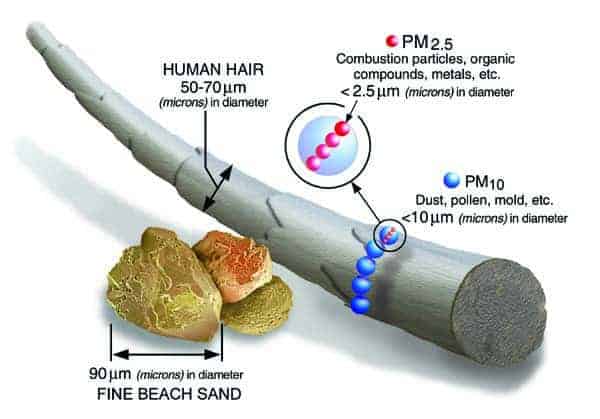What Is Pm 2.5 Made of
Of the various forms of air pollution, Particulate Matter is the deadliest as they can penetrate deep into the lungs and thoracic chambers. Let us see what this particulate matter is and why it is a matter of great concern.
There are different types of particulate matter
- Suspended Particulate Matter (SPM)
- Thoracic and Respirable Particles
- Inhalable Coarse Particles (diameter between 2.5 micrometres to 10 micrometres – PM 10)
- Fine Particles (diameter 2.5 micrometres or less – PM 2.5)
- Ultrafine Particles
- Soot
Sources of Particulate Matter
Natural causes of particulate matter constitute volcanic dust, dust storms, sea spray, forest fires, and living vegetation and so on.
Another source of particulate matter is human activities like industrial pollution, vehicular exhausts, power plants, tobacco smoke, and release of volatile organic compounds like air-conditioner and refrigeration exhausts, insect sprays, and cooking.
The size of the particulate matter rather than the chemical composition is the crucial factor here. The size determines where the particulate matter comes to rest in the respiratory tract. The cilia and the mucus in the nose and the thoracic region can filter out the SPM and thoracic Respirable particles.
The dangerous ones are the PM 10 and PM 2.5 that can penetrate the bronchi and the lungs thereby causing health problems.
The PM 2.5 can penetrate into the gas exchange region of the lungs. Thus, it can cause problems like respiratory infections, asthma, and even heart disease.

How big are the PM 2.5 and PM 10?
Micrometre or micron is a unit of measurement for distance. PM 2.5 constitutes particulate matter of size 2.5 microns or less.
Similarly, PM 10 refers to the particulate matter of size 10 microns and less. The width of a strand of human hair is around 100 microns. It will give you an idea of the size of PM 2.5 and PM 10.
Health problems when you inhale PM 2.5 and PM 10

Particles that have a size greater than 10 microns do not reach the respiratory tract as the cilia and mucus can trap them. The dangerous ones are the smallers.
Inhaling such particulate matter can cause various health problems like asthma, lung cancer, premature delivery, low birth weight, congenital disabilities, cardiovascular diseases, and respiratory diseases.
There have been instances of DNA mutation, heart diseases, and early death because these ultrafine particles can penetrate the lungs and bloodstream unfiltered.
Particulate matter can also affect vegetation as these particles can clog the pores and interfere with photosynthesis. It can lead to stunted growth and mortality in plants.
Air quality standard for PM 2.5 in outdoor air
PM 2.5 and PM 10 affect every country in the world. Hence, each country has set its limits for particulates in the air. The following table (courtesy Wikipedia) will make matters clear.
| Country | PM 10 | PM 2.5 | ||
| Yearly average | Daily average | Yearly average | Daily average | |
| Australia | None | 50 microns/m3 | 8 microns/m3 | 25 microns/m3 |
| China | 70 microns/m3 | 150 microns/m3 | 35 microns/m3 | 75 microns/m3 |
| European Union | 40 microns/m3 | 50 microns/m3 | 25 microns/m3 | None |
| Hong Kong | 50 microns/m3 | 100 microns/m3 | 35 microns/m3 | 75 microns/m3 |
| Japan | None | 100 microns/m3 | 15 microns/m3 | 35 microns/m3 |
| South Korea | 50 microns/m3 | 100 microns/m3 | 15 microns/m3 | 35 microns/m3 |
| Taiwan | 65 microns/m3 | 125 microns/m3 | 15 microns/m3 | 35 microns/m3 |
| USA | None | 150 microns/m3 | 12 microns/m3 | 35 microns/m3 |
What are the factors that affect PM 2.5 levels?

Climatic factors affect PM 2.5 levels. Wind can change the levels considerably. They can both carry the particles away and bring them in as well.
When there is a higher concentration of PM 2.5 in the outdoor air, the air appears hazy with reduced visibility levels. You experience similar conditions during fog or high humidity. The concentration of PM 2.5 is more during the winter season because the air becomes heavy.
Similarly, our indoor activities determine the levels of PM 2.5 inside the house. Lighting of oil lamps, candles, and cooking activities like frying or sautéing can increase PM 2.5 levels. Similarly, use of insect sprays, aerosol sprays, and air conditioners can also increase the levels.
What is the solution?
The best solution is to install an air purifier in the house. You get air purifiers of sound quality in the market. Choose the one most appropriate to your requirement and ensure that your family gets healthy air to breathe.
Sources: Wikipedia, npi.gov.au, Health.ny
- Types of Filters Used in Air Conditioners and Air Purifiers
- Top 5 Myths about the Air Purifiers Debunked!
- Air pollution in Delhi Essay – Case Study!
- Effects of Air Pollution on Human Health – Kills 7 Million a Year!
- Indoor Air pollution – Causes & Ways to Decrease!

VS Chaitanya is a Computer engineer, creator, and editor in chief of Kitchenarena. He is a Microsoft Certified Solutions Expert and has experience of Ten years in technology news reporting and his area of expertise includes Large Appliances and Electronics.
Source: https://www.kitchenarena.in/pm-2-5-pm-10/